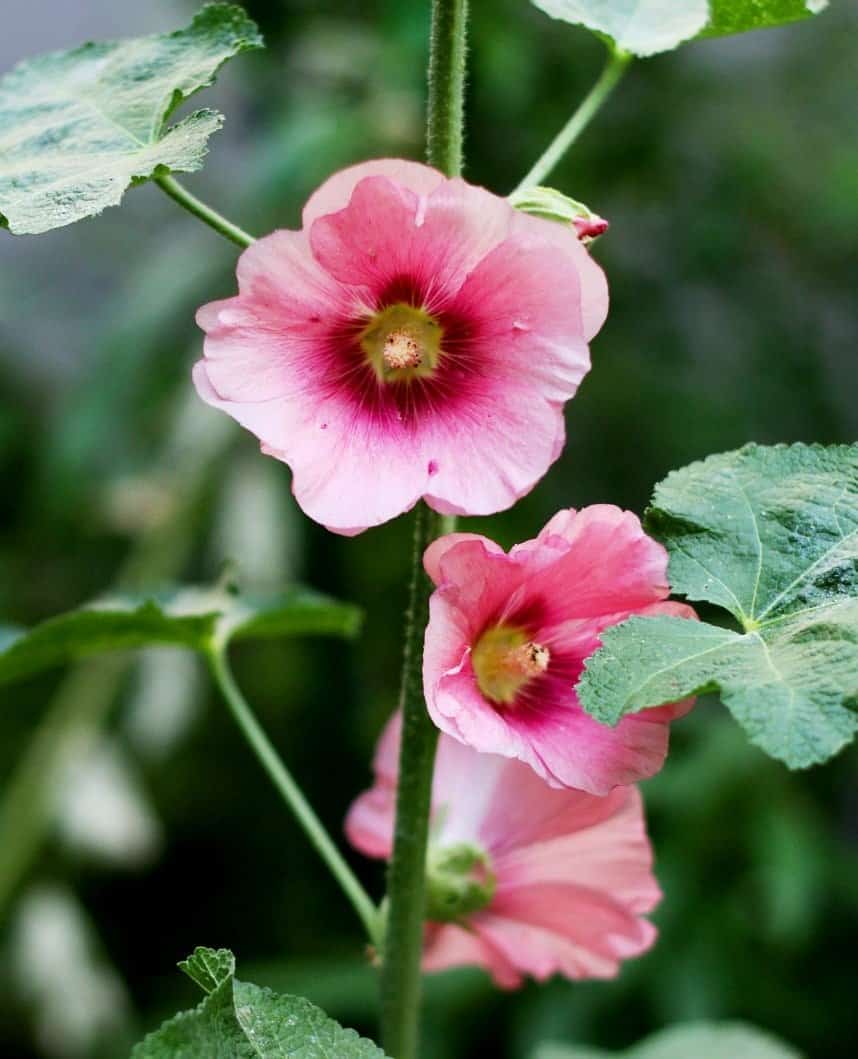
The light is lasting longer these days, and that spurs my interest in getting things growing. I have an army of primula seeds to germinate, a future investment for spring 2013. Most perennials grown from seed bloom in the second year, but there are a few that flower the first year, if they’re planted early enough. One is fig leaf hollyhock (Althaea ficifolia, syn. Alcea ficifolia, Zone 3), a big (in every sense!) favourite of mine.
Hollyhocks are a useful vertical design reference in a perennial border. Their upright in-your-face posture adds interest to what might be a uniformly low group of perennials. Hollyhocks stand proud at nearly seven feet (2 m) tall, and put their long-blooming flowers at eye level, where you can see them best.
Dwarf perennial hollyhock, Spring Celebrity (stokeseeds.com) also blooms quickly—14 to 16 weeks from seeding. It grows 30 inches (75 cm) tall and the flowers are a mix of semi-double and double in the first year, and all double the second year. Spring Celebrity is bred from A. rosea, and highly susceptible to rust disease, worth knowing if fungal hollyhock rust is a problem in your garden.
I’ve grown lots of different hollyhocks, and encountered a serious problem with rust disease. My garden seems to be the North American source of Puccinia malvacearum spore, just waiting for a hollyhock leaf to peek above ground. For several years my double A. rosea hollyhocks were severely afflicted with the rusty orange pustules filling their foliage.
But hollyhock rust is a distant memory since I switched to fig leaf (sometimes called Antwerp) hollyhock, a more rust-resistant species. The deeply lobed foliage has been entirely disease free in my garden, and it thrives with half day to full day sun. I grow the Happy Lights strain (parkseed.com) that features a pretty mix of pastel and deeply saturated colours. Happy Lights is a single flower with ruffled petals and contrasting golden throats. You can also look at Antwerp mixed hollyhocks (veseys.com) for a slightly different mix with predominately darker colours.
Start seed indoors in February under plant lights or in a sunny window in order for plants to reach blooming size the first season. I start the seeds in two-litre milk cartons (with drainage holes cut in the bottom) to allow them deep root development. I feed them every third week with a close to balanced fertilizer (18-18-21) diluted to half strength. The plants will be about 12 inches (30 cm) tall by the time they go outside in May. It’s not possible to accurately predict the eventual flower colour from seedling foliage. The darker colours tend to make slightly smaller plants, if that’s any help to you, but there’s no guarantee.
The basal rosette is usually about 24 inches (60 cm) wide, and I trim off the outer leaves to reduce the plant’s footprint to about 16 inches (40 cm). The loss of foliage doesn’t seem to inhibit the plant’s ability to produce adequate energy. These tall beauties are impressive in bud and flower, and you don’t need a lot to make a statement. Just one plant is good for placing strategically where it can be seen and admired. For a distant view, try a grouping of three to five plants at the back of the garden. Hollyhocks like good drainage and don’t resent slightly dry soil. If you establish a generous row alongside a garage, well, that’s hollyhock heaven!









I think I have a fig leaf hollyhock growing in a mint and chive garden by my house foundation. I have a pic. We have no idea how it got there. We may have bought it a couple years ago. We aren’t sure?
Chow did this happen. Could it have developed from a root or seed that was planted another year?
I have heard that growing mint with hollyhocks prevents rust, but I haven’t tried it yet.
Where do you get seeds for fig leaf hollyhocks? No Canadian supplier seems to have them.
did you ever fined out where to buy seeds
Floribunda Seeds in Ontario has them in their 2017 catalogue. $3/pkg.
Hi Liz (Feb. 6),
I’m sure you’ll find fig leaf hollyhock an improvement. It really has resistance to rust disease, and the flowers are lovely!
— Judith
Thanks for the info. I always grow hollyhocks and rust is always a problem before the growing season is over. I can’t wait to try the rust-resistant variety suggested.